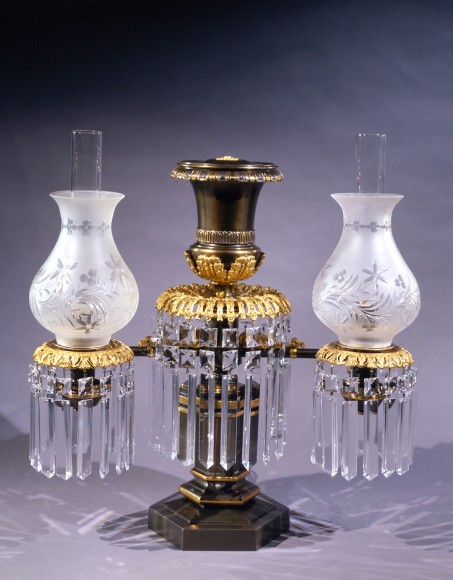Double Argand Lamp, after 1832
Thomas Messenger & Sons, Birmingham and London, England (active 1797–1920)
Retailed by Hayden & Gregg & Company, Charleston, South Carolina (active 1832–46)
Gilt and patinated bronze, glass shades, blown, frosted, and wheel-cut, glass prisms, and glass chimneys
21 1/8 in. high, 19 in. wide, 9 3/8 in. deep
Signed and inscribed (on embossed brass label, attached to one of the burner tubes): MESSENGER & SONS / LONDON & BIRMINGHAM / MANUFACTURED FOR / HAYDEN & GREGG & CO. / CHARLESTON / S.C.; (on iron weight within base): MESSENGER & SONS
There were many innovations in the field of lighting during the Neo-Classical period. The design of this Argand lamp relies ultimately on the discoveries of the Franco-Swiss chemist, Ami Argand (1759–1803). Argand employed new principles of combustion in the invention of a burner consisting of two concentric tubes surrounding a wick. These tubes drew a double current of air to feed the flame. The Argand workshop was the first to perfect the use of a glass tube as a chimney to increase the upward flow of air. The combination of the two tubes and the glass chimney produced a larger flame that provided a good deal more light—twelve times that of a single candle—and permitted much more activity at night than had been possible before. However, the oil used was too thick to be drawn up by the wicks, so these lamps had a reservoir placed higher than the wick so that the flow of oil could be aided by gravity. In a negative way, these reservoirs caused a large shadow, which ultimately led to the development of the sinumbra (i.e. “without shadow”) lamp, in which the fuel was stored in a doughnut-shaped ring, which produced no shadow.
The present lamp bears an embossed label on one of its burner tubes, which reads: “messenger & sons / london & birmingham / manufactured for / hayden & gregg & co. / charleston / s.c.” For many years, the single name that typically appeared on such lamps, i.e., “B. Gardiner, N. York,” “j. & i. cox, new york,” etc., was considered to be that of the maker, although disassembly of the lamps has often revealed the name of the maker on the upper side of the iron weight housed within the base. The present lamp, with its extensive text, clearly identifies both the manufacturer and the retailer. Messenger was in business for a very long time, and it is not unlikely that the firm supplied a considerable percentage of the Argand lamps made in England and exported to the United States. The firm typically placed only the name of the retailer on the embossed brass plate attached to the burner, but did also occasionally place its own name there as well. What is unusual about the present example is the identification of a Charleston, South Carolina, retailer, which has previously been very rarely encountered on lamps of this sort. Another example is a very simple double Argand lamp in collection of the Charleston Museum, Charleston, South Carolina (no. HL0051; photographs in Hirschl & Adler archives), which bears an embossed brass label on one of its burners which gives the name of T. C. Salt of Birmingham as manufacturer, with the further notation that it was “imported by / hayden gregg & co / charleston, s c”, which adds to our knowledge simply the fact that a firm such as Hayden Gregg & Company was acquiring Argand lamps from more than one English source.
Hayden, Gregg & Co. was active in Charleston not only as a retailer but also as a silversmithing firm.

